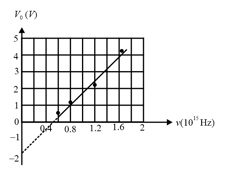HARD
Earn 100
Light of wavelength is incident continuously on a Caesium ball (work function ). The maximum potential to which the ball will be charged is
(a)
(b)
(c)zero
(d)infinite
50% studentsanswered this correctly
Important Questions on Dual Nature of Radiation and Matter
MEDIUM
The maximum velocity of the photoelectrons emitted from the surface is when light of frequency falls on a metal surface. If the incident frequency is increased to , the maximum velocity of the ejected photoelectrons will be:
MEDIUM
Light of wavelength is incident on a metal with work function . The de Broglie wavelength of the emitted electron is:
EASY
The electric field of certain radiation is given by the equation falls in a metal surface having work function The maximum kinetic energy of the photoelectrons is [Planck's constant and electron charge ]
HARD
A metal plate of area is illuminated by a radiation of intensity . The work function of the metal is The energy of the incident photons is and only of it produces photo electrons. The number of emitted photo electron per second and their maximum energy, respectively, will be:
MEDIUM
When a certain metallic surface is illuminated with monochromatic light of wavelength the stopping potential for photoelectric current is and when the same surface is illuminated with light of wavelength the stopping potential is The threshold wavelength of this surface for photoelectric effect is
MEDIUM
In a photocell circuit, the stopping potential, is a measure of the maximum kinetic energy of the photoelectrons. The following graph shows experimentally measured values of stopping potential versus frequency, of incident light.

The values of Planck's constant and the work function as determined from the graph are (taking the magnitude of electronic charge to be,),
HARD
The magnetic field associated with a light wave is given, at the origin, by If this light falls on a silver plate having a work function of what will be the maximum kinetic energy of the photoelectrons?
MEDIUM
Radiation of wavelength is incident on a photocell. The fastest emitted photoelectron has a speed . If the wavelength is changed to , the speed of the fastest emitted photoelectron will be
MEDIUM
Photons with energy of are incident on a cathode, in a photoelectric cell. The maximum energy of emitted photoelectrons is When photons of energy are incident on , no photoelectrons will reach the anode, , if, the stopping potential of relative to is
MEDIUM
Photons of wavelength are incident on a metal. The most energetic electrons ejected from the metal are bent into a circular are of radius R by a perpendicular magnetic field having a magnitude B. The work function of the metal is (Where symbols have their usual meanings).
MEDIUM
Photons of energy are incident on two metals and with work functions and , respectively. The minimum de-Broglie wavelengths of the emitted photoelectrons with maximum energies are and , respectively, where is nearly,
MEDIUM
When a metallic surface is illuminated with radiation of wavelength , the stopping potential is . If the same surface is illuminated with radiation of wavelength , the stopping potential is . The threshold wavelength for the metallic surface is:
EASY
The photoelectric threshold wavelength of silver is . The velocity of the electron ejected from a silver surface by ultraviolet light of wavelength is:-
MEDIUM
A laser light of wavelength is used to weld Retina detachment. If a laser pulse of width and power is used, the approximate number of photons in the pulse are (Take Planck's Constant,
MEDIUM
When ultraviolet radiation of a certain frequency falls on a potassium target, the photoelectrons released can be stopped completely by a retarding potential of If the frequency of the radiation is increased by this stopping potential rises to The work function of potassium is
MEDIUM
A photoelectric surface is illuminated successively by monochromatic light of wavelengths If the maximum kinetic energy of the emitted photoelectrons in the second case is times that in the first case, the work function of the surface is :
MEDIUM
When photons of wavelength are incident on an isolated sphere, the corresponding stopping potential is found to be . When photons of wavelength are used, the corresponding stopping potential was thrice that of the above value. If light of wavelength is used then find the stopping potential for this case:
MEDIUM
On a photosensitive material, when the frequency of incident radiation is increased by , the kinetic energy of emitted photoelectrons increases from to . The work function of the surface is
EASY
Maximum kinetic energy of a photoelectric varies with the frequency of the incident radiation as
HARD
In a historical experiment to determine Planck's constant, a metal surface was irradiated with light of different wavelengths. The emitted photoelectron energies were measured by applying a stopping potential. The relevant data for the wavelength of incident light and the corresponding stopping potential are given below:
| 0.3 | 2.0 |
| 0.4 | 1.0 |
| 0.5 | 0.4 |
Given that Planck's constant (in units of ) found from such an experiment is :

